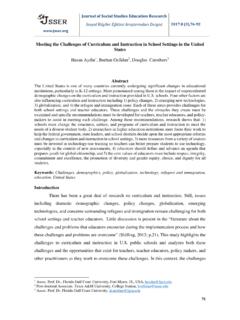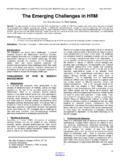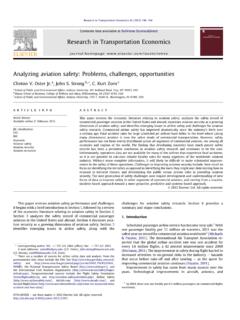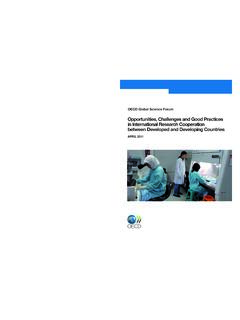Transcription of Opportunities and Challenges in Enhancing Agriculture in ...
1 Opportunities AND Challenges IN Enhancing AGRICULTURAL DEVELOPMENT IN ZAMBIA Advisory Note submitted to The Ministry of Agriculture and Livestock 21st February 2015 1 INTRODUCTION The revised Sixth National Development Plan, aligned to the PF Manifesto, recognizes that agricultural development is critical for achieving inclusive growth and poverty reduction in Zambia. These documents clearly indicate that to attain more inclusive agricultural growth there is urgent need to address the unbalanced Agriculture policies which have favoured maize production and disadvantaged the production of other crops . Despite this recognition, very little progress has been made to diversify agricultural spending away from its current focus on maize, a low value crop. The consequences of the current policy approaches, where the majority of the agricultural budget is used to subsidize inputs for maize production and maize markets, are clear.
2 Despite achieving annual growth rates of more than 6 per cent in Agriculture , crop yields remain low by international standards and rural poverty rates remain stubbornly high at about 80 per cent. The paradox of growth without poverty reduction suggests that income inequality in rural areas is growing rapidly, while limited progress is being made to improve the productivity of small-scale farms. At the heart of Zambia s agricultural growth paradox is its heavy reliance on the Farmer Input Support Programme (FISP) and output price support via the Food Reserve Agency (FRA). These two programmes have been costly and ineffective at addressing high rural poverty rates and low crop productivity. Moreover, they tend to disproportionately support farmers with larger land sizes and asset endowments. For agricultural spending to effectively address the Challenges of entrenched rural poverty and low crop productivity, it must be better targeted to poorer farmers, it must further target crops that are better suited for the small land sizes that predominate in rural Zambia and must be less prone to appropriation by more wealthy and powerful individuals.
3 The crops promoted by Government should be those that are conducive to a given agro-ecological zone and also the same should be economically profitable without government input subsidies or output price support. Current agricultural policies in Zambia do not achieve these objectives. Instead, they constrain growth by under-funding investments in key agricultural growth drivers that can benefit all rural people, such as rural infrastructure (roads, rail, and telecommunication), agricultural research and development, market information, irrigation and institutions that foster the development of effective markets, and complementary services such as agricultural extension and credit. Also, the maize centric policies are undermining Zambia s ability to become a stronger player in the regional agricultural sector, which further inhibits inclusive growth. 2 This Advisory note is the result of a stakeholder consultation process spearheaded by Indaba Agricultural Policy Research Institute.
4 The policy options and recommendations come from years of broad consultation with key agricultural stakeholders and the results from extensive empirical studies in Zambia. The expected impact of adopting the proposals contained in this document include increased productivity of Zambian Agriculture , reduced rural poverty rates, increased national food security, crop diversification, improved agricultural markets, less pressure on the Treasury stemming from agricultural subsidies and Zambia emerging as a leading regional exporter of agricultural products. Continuation of the status quo will lead to mounting Treasury deficits, wealth inequality, continued high rural poverty rates, and will not effectively promote production or productivity growth of other commodities apart from maize. Challenges AND RECOMMENDED POLICY OPTIONS THE CURRENT HUGE FRA MAIZE STOCKS Zambia in 2014 recorded yet another maize bumper harvest of million metric tons (MT).
5 As usual, the policy makers were confronted by the classic food price dilemma. On the one hand, they were under pressure to ensure that maize producers received a higher price in a bumper harvest year and on the other hand, they were under pressure to keep mealie-meal prices at tolerable prices for consumers. Unfortunately, the government has not been very successful in striking a balance between these two competing objectives mainly because the solutions tend to alienate the private sector through unpredictable policies. In responding to this unprecedented bumper harvest, the FRA once again departed from the budgeted purchase target of 500,000 tonnes of maize and ended up buying more than twice that target amount placing enormous pressure on the nation s finances which are already very stretched as witnessed by the growing budget deficit. Currently, FRA is sitting on massive quantities of maize which if not disposed of before the next harvest, the same will continue to act as a source of uncertainty in the 2015/16 marketing season.
6 In particular, a situation of large stocks of maize purchased in 2014 and carried forward into the 2015/16 marketing season will make private sector actors less willing to buy maize from smallholder farmers, it will undermine the banks willingness to support commercial maize production and grain storage and will further continue to impose a massive financial burden on the Treasury. If nothing 3 is done immediately to dispose the large maize quantities, a large amount of it will potentially go to waste/spoiled because of inadequate and poor storage. Policy Options/Recommendations The current efforts to export maize to neighboring countries especially Zimbabwe would be inadequate to deplete the stocks before the next harvest due to existing transportation bottlenecks, non-competitive FRA price and insufficient maize demand in the region. Therefore, there is need to start thinking about other ways of disposing of the stocks in ways that contribute to Zambia s national interests.
7 We recommend the following short-term measures: 1. Consider discounting the price to increase demand for Zambian maize which is currently not competitive in the region; 2. Consider selling maize to the World Food Programme (WFP) and other similar institutions at discounted price for delivery to flood- affected countries such as Malawi, Mozambique and other disaster affected countries 3. Consider making FRA maize stocks immediately available for purchase by both formal and informal traders, hammer millers and the general public. This could be done through FRA setting up fair price distribution centres in high population density areas throughout the country. In addition, FRA should consider opening its sheds around the country and sell maize to rural consumers who would like to take grain to local hammer millers. This will likely help to lower mealie meal prices as large millers will be forced to compete with hammer millers.
8 In addition, this would promote maize value addition especially among backyard and small-scale poultry producers. 4. The government should consider donating more maize to school feeding programmes throughout the country 5. Consider swap deals of maize for livestock with countries like Namibia and Botswana. 6. Consider swap deals of maize for oil or fertilizer with other countries This is urgent and requires pragmatic and quick Government action. This should not be business as usual. 4 HOW CAN GRZ INVEST THE LIMITED BUDGET RESOURCES IN THE AGRICULTURAL SECTOR? The distribution of the agricultural budget in the recent past has not placed enough emphasis on broad-based public investments. A significant proportion of the poverty reduction programmes (98 per cent) of the Agriculture budget is being spent on the FISP and FRA, which have not proved effective at boosting productivity or reducing rural poverty (appendix 1).
9 Though politically popular, as the experience in Zambia and other countries in the region demonstrates, these subsidy programs are typically less effective at stimulating agricultural growth than investments in research, extension, roads and other public goods, because subsidies often displace private spending that would otherwise occur and are prone to diversion and manipulation. Heavy spending on FISP and FRA has left few resources to invest in these well recognized drivers of agricultural growth and stifled diversification as the country policies are maize-centric. Given than most farmers are land constrained (cultivating on average 2 hectares or less), policies that promote continuous cultivation of a low value crop such as maize will be less likely to solve the poverty problem facing most Zambian smallholders. The other major problem is the continued delayed budget releases to the Ministry of Agriculture and Livestock.
10 For example, extension staff regularly receive their salaries but field operational funds (recurrent expenditure) are released late affecting the delivery of extension services. In addition, the delayed releases do not only affect operations, but affect the performance and/or implementation of other agricultural programs. Policy Options/Recommendations 1. Rebalance government funding to key drivers of agricultural growth. Reorientation of spending, away from FRA and FISP towards increased investment in public goods including: a. irrigation development as a means to mitigate drought and improve productivity; b. crop, soil, and livestock science research and development to enhance genetic advances and refinements in the adaptation of improved practices and technologies; c. extension programs, particularly focusing on effective and appropriate input use, and integrated soil fertility management practices to improve soils and raise crops response to inorganic fertilizer delivered; and d.









